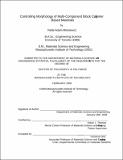Controlling morphology of multi-component block copolymer based materials
Author(s)
Mickiewicz, Rafal Adam, 1974-
DownloadFull printable version (28.45Mb)
Other Contributors
Massachusetts Institute of Technology. Dept. of Materials Science and Engineering.
Advisor
Edwin L. Thomas.
Terms of use
Metadata
Show full item recordAbstract
The ability of block copolymers to self-assemble into ordered microstructures has attracted much interest both from a pure scientific perspective and for their potential in numerous industrial applications. The microphase separation of block copolymers has been successfully exploited in a wide range of applications, such as templating and lithography, enhancement of mechanical properties, and nano reactor schemes. This thesis focuses on the characterization of the morphology in composite systems where one or more of the components is a block copolymer. In the first part of this thesis, binary blends of very high molecular weight diblock copolymers with a low molecular weight triblock copolymer are investigated. The high molecular weight diblock copolymers are very strongly segregating, with interaction parameter values, XN, in the range 470 - 1410. The phase diagram revealed a large miscibility gap for the blends, with macrophase separation into two distinct types of microphase separated domains and implied virtually no solubility of the much higher molecular weight diblocks in the triblock. For certain blend compositions, morphological transitions from the lamellar to cylindrical and bicontinuous structures were also observed, even though the overall composition in the blend would be expected to favor the lamellar microstructure. This was found to result from the compositional asymmetry of the triblock copolymer influencing the curvature of the inter-material dividing surface (IMDS). Finally, a strong segregation theory model was used to interpret the observed results. In the second part of this thesis the microstructure formation in nanocomposites based on a liquid crystalline side chain block copolymer (LCBCP) and gold nanoparticles was investigated. The location of the nanoparticles was found to not only depend on the surface chemistry of the gold nanoparticles, but also on the self-organization within the liquid crystalline domain of the LCBCP. The nanoparticles were excluded from the liquid crystalline domains due to the high free energy penalty of disrupting the smectic layering. The final location of the nanoparticles within the composite was determined by the nature of the stabilizing surface coating. The work presented in this thesis revealed a number of interesting tools which are useful for obtaining a wide range of morphologies in multi-component block copolymer systems.
Description
Thesis (Ph. D.)--Massachusetts Institute of Technology, Dept. of Materials Science and Engineering, 2009. Includes bibliographical references.
Date issued
2009Department
Massachusetts Institute of Technology. Department of Materials Science and EngineeringPublisher
Massachusetts Institute of Technology
Keywords
Materials Science and Engineering.